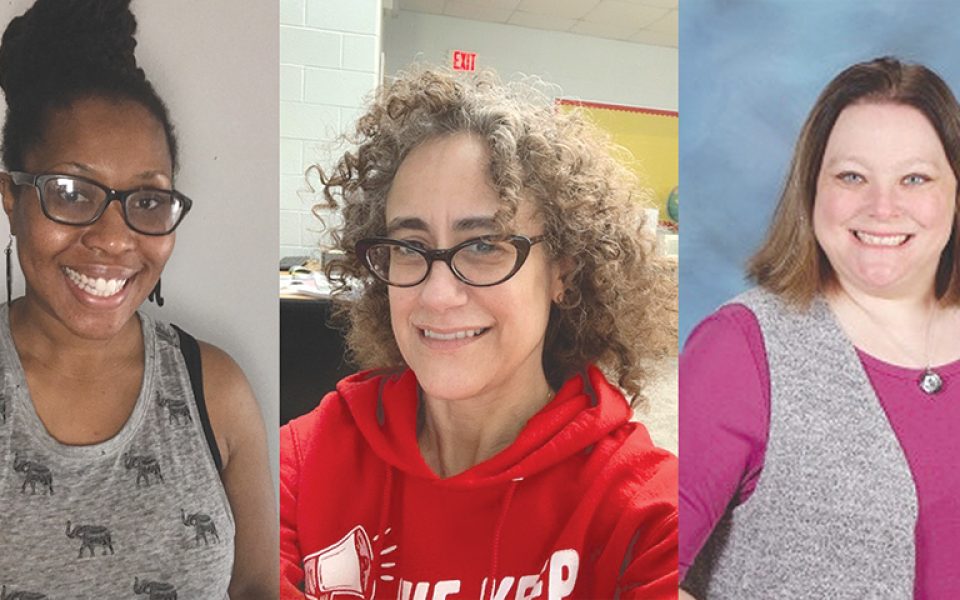Featured photo: Teachers Micah Jackson, Deb Greene and Amy Harrison share their experiences of how they’ve been handling their mental health (courtesy photos)
As students return to the classroom on Monday, teachers’ feelings of hope are muddled by apprehension about rising COVID-19 cases caused by the Delta variant.
“I’m really nervous,” says Deb Greene, who teaches English as a second language at Northern Middle and High School. “I’m not nervous for myself, but I’m very worried for my kids who are in middle school who are not old enough to be vaccinated yet. My students come from families who may or may not be vaccinated, or have multiple generations in the homes. I really worry about their safety and their sense of safety. I feel like there’s going to be a lot of commentary about whether they are going to be masked.”
Both Guilford and Forsyth Counties officially go back to school on Monday, and both have instituted mask mandates within schools. Greene, who says she got vaccinated with both doses of Pfizer as soon as she was eligible, has been teaching since 2003. Prior to working at Northern, she was at Ferndale Elementary; she switched schools in the middle of the pandemic in August of last year. And while she’s nervous about the effects of the recent surge in cases on her students, she is excited to be teaching in person again.
“I did not want to teach online,” Greene says. “I hated teaching from home, but I was terrified of teaching in person.”

Having to shift from the classroom to the new online platforms last year was one of the most stressful parts of 2020 for Greene.
“That first year was very stressful in a way because everything was new,” Greene says. “I didn’t know how to teach online; I didn’t know my colleagues. I felt like a new teacher in my first year all over again.”
This kind of stress and subsequent burnout has been a common motif for teachers across the country. According to a survey conducted by the RAND Corporation between May and October 2020, the percentage of educators worried about burnout rose from 25 to 57 percent. A study by the CDC Foundation found that more teachers were considering leaving the profession altogether and that an increased number were experiencing symptoms of depression.
For Greene, she says that the sudden shift to teaching online was what weighed the heaviest on her mental health.
“Every week we were told we had to learn a new skill online and implement it, and some of that I found extremely stressful,” she says. “That’s what stressed me out, because I spent more time making my Canvas page look cute rather than teaching and checking in on my students. So yeah, that first spring was pretty terrible.”
During one particularly difficult day, Greene says she was having so much trouble getting Canvas, the online learning platform, to work that she was brought to tears.
“I lost it,” she says. “I was like, ‘I’m going to retire,’ even though I couldn’t retire.”
Amy Harrison, a special education teacher at Reedy Fork Elementary echoed Greene’s stresses of feeling like a new teacher despite having 22 years of experience.
“I think it was like starting over,” Harrison says. “Learning all of the technology and having to teach the kids how to use the technology without them sitting here in person and having to teach them over the computer, it was like going back and being in my first year teaching again…. We had to flip our classrooms in a week. It was really hard, and at that point we only thought we would have to do it for two weeks.”
In addition to adapting to the changes, the uncertainty and the back and forth of it all really affected Harrison.
“I like knowing what my expectations are,” Harrison says. “The worst part was not knowing. Like when our school board said that the positivity rate had to be less than 5 percent but then they added other factors into it. And I’m also thinking about how the kids were going to react knowing what school was supposed to be like.”
But in the end, Harrison says that the kids ended up adapting to the changes better than some of the adults.

“We had a workday before the kids came back, and that was one of the most stressful days I’ve had in a while because I didn’t know how they were going to react,” she says. “And quite honestly, I worried for nothing. The kids did a great job following procedures.”
One of Harrison’s favorite memories from the last year was when her students were able to get together outside and meet in person for the first time for their end-of-year celebration.
“You could see the bonds that they made even though they had not met in person,” Harrison says. “They still had their little friend groups.”
Now, she says she’s less concerned with how the kids will adapt to being back in the classroom and more worried about how the rise in COVID cases might affect them.
“I’m excited to see all of the kids in the building,” she says. “But I’m also apprehensive about the Delta variant and the fact that none of my students are old enough to be vaccinated.”
Harrison, who is fully vaccinated with Moderna, says she was more comfortable being in the classrooms last year because she didn’t have to deal with the Delta variant. She says she’s glad that the school board mandated masks for everyone and doesn’t think her kids will have any issues with them.
“The kids don’t have an opportunity to choose whether or not to be vaccinated,” she says. “And our kids did fairly well with masks, they did a good job of wearing them in the classrooms.”
‘It’s important to set boundaries’
Teacher Micah Jackson, who teaches English for Winston-Salem/Forsyth County Schools said she feels very wary about reentering the classroom.
“I’m 100 percent uncomfortable with it,” she says. “This whole pandemic I have not taught inside of a classroom with actual students.”

Jackson, who says she is “self-diagnosed OCD,” did not wish to disclose her vaccination status. For months, Jackson and her family have been very careful and because of that, she says she doesn’t feel ready to go back into the classroom. Last year, when teachers were told they would have to teach in person again, Jackson says she opted to take unpaid discretionary leave rather than go back to in-person. Now, as Monday approaches, she’s feeling nervous again.
“If the numbers are higher now, why does it make sense to play this game?” she asked.
Jackson, who has been teaching for 14 years, says that she loves teaching but that she felt like she didn’t have many options last year.
“I honestly didn’t want to do the discretionary leave,” she says. “But they didn’t care to do any other options. That was a choice that was hard for me. I enjoy teaching so I didn’t want to do it.”
Greene, who doesn’t have kids of her own, says that the notion of feeling stuck with limited options is something she’s heard from other teachers. And for those that have their own kids, she says teachers are feeling burnt out.
“We keep getting more put on our plates and we aren’t seeing more money in our wallets,” Greene says. “Last year, my raise was $3 per month. And on top of content, the big push this year which I agree with, was to take on more of social emotional wellbeing of our students, but I think that some of the people who are making these decisions aren’t thinking about the social emotional wellbeing of our teachers.”
For her mental health, Greene says she’s been practicing more yoga and meditating. She has also had to learn to set hard boundaries for herself.
“My main thing is to demand me time,” Greene says. “Put it down. Stop at 5 even if it’s not done…. I think especially teachers who want to do everything that we’re asked to do, it’s more important that you take care of yourself and our families. I do not check my emails on Saturdays or Sundays. Basically, we do not get paid enough to be as married to our jobs as we often are.”
Harrison says she agrees.
“It’s important to set boundaries,” she says. “Because we were at home and we were online, some parents thought they could call at 9 p.m. or call over the weekend, but know that once those boundaries are set, to keep them.”
For the most part, she says, parents have been very understanding and appreciative of her throughout the pandemic.
“It’s about having an open line of communication,” she says. “Just explaining, ‘This is how it is and this is how we’re keeping everyone safe.’”
Jackson says that setting boundaries for your health in the middle of a pandemic is paramount, too.
“You have to do what is going to make you happy and comfortable,” she says. “This is not a normal situation; this is something serious. This is something real that affects lives to the point of dying. We’ve had some teachers in this district die, so you have to put yourself first and your family first and whatever that looks like to you is what you have to do.”
These days, Greene thinks of her job like she would if an emergency happened on a plane.
“At the end of the day, I think about the airplanes,” she says. “We gotta take care of ourselves first and then take care of the kids or people around you.”
And despite the difficult year and a half that she’s had, Greene says she had some great experiences.
During an end-of-year slideshow, one of her students told her she was “her role model” and when she told her eighth graders that she would be teaching them in high school too, they clapped in excitement. Those are the moments she teaches for, she says.
“It was just such a fulfilling feeling,” she says. Every year I look for moments that make the whole year worthwhile and last year I got two of them.”
To learn more about how kids are dealing with going back to school, read our articles here and here.
Learn more about Guilford County Schools’ mental health support for students at gcsnc.com/Page/26779. For Winston-Salem/Forsyth County Schools, visit wsfcs.k12.nc.us/Page/785.
Join the First Amendment Society, a membership that goes directly to funding TCB‘s newsroom.
We believe that reporting can save the world.
The TCB First Amendment Society recognizes the vital role of a free, unfettered press with a bundling of local experiences designed to build community, and unique engagements with our newsroom that will help you understand, and shape, local journalism’s critical role in uplifting the people in our cities.
All revenue goes directly into the newsroom as reporters’ salaries and freelance commissions.


Leave a Reply